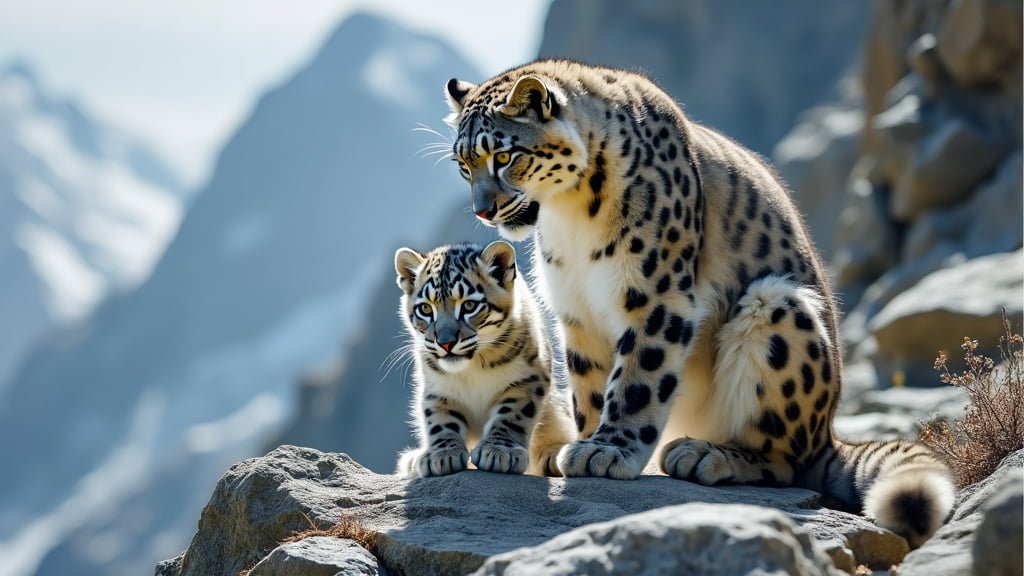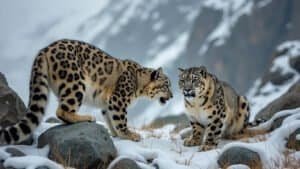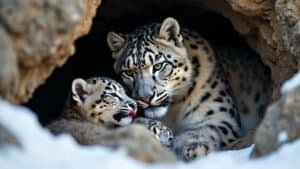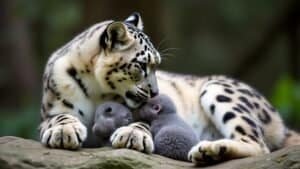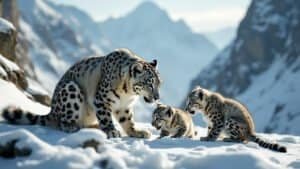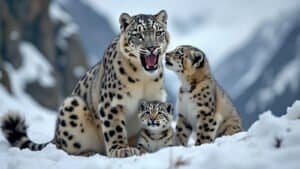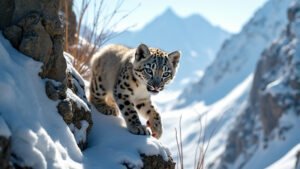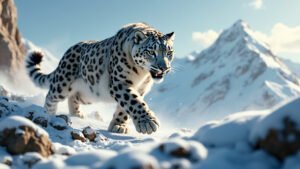Introduction
Understanding the family dynamics of snow leopards is crucial for conservation efforts and for gaining insight into the behavior of this elusive big cat. While the role of female snow leopards in raising cubs is well-documented, the involvement of males remains less clear
This article explores the paternal role of male snow leopards, examining whether they contribute to raising their offspring, how they interact with their cubs, and what recent research reveals about their role in the survival and development of the young
Male Snow Leopards and Their Role in Cub Rearing
The role of male snow leopards in cub rearing has been a subject of debate among wildlife biologists and conservationists. Snow leopards are known for their solitary nature, often traversing vast, rugged terrains alone
However, recent studies have started to shed light on the interactions between male snow leopards and their offspring, revealing surprising insights into their potential role in cub rearing
Interaction Between Male Snow Leopards and Cubs
Unlike many other big cat species where males are typically absent from the cub-rearing process, snow leopards display a more complex behavior. Observational studies and camera trap footage have documented instances where male snow leopards are seen in proximity to their cubs and the mother
In some cases, males have been observed engaging in grooming behaviors, a sign of bonding and care typically associated with females. This interaction is crucial during the early months of a cub’s life when they are most vulnerable to external threats
A study published in the Journal of Mammalogy in 2018 highlighted that male snow leopards occasionally stay near their offspring’s den, possibly as a protective measure against predators or rival males
Although these instances are not the norm, they suggest that male snow leopards may play a more active role in ensuring the survival of their cubs than previously thought
Protective Behavior of Male Snow Leopards
The solitary and territorial nature of snow leopards often implies that males are primarily focused on defending their territory from intruders. However, this territorial behavior may indirectly benefit the cubs as well
By securing and patrolling a large territory, a male snow leopard reduces the risk of rival males intruding and posing a threat to the cubs. Additionally, the presence of a male in the vicinity can deter predators such as wolves and other potential threats
Some evidence suggests that males might also engage in direct protective behaviors, although this is less commonly observed. For instance, instances of males positioning themselves between their cubs and potential dangers have been recorded, although such behaviors are rare and not widely documented in scientific literature
Provision of Food and Resources by Males
One of the most critical aspects of cub rearing is ensuring a steady supply of food. In most big cat species, the female is solely responsible for hunting and providing for the cubs
However, there are rare instances where male snow leopards have been observed sharing their kills with cubs and females. This behavior is unusual and contrasts with the more typical solitary feeding patterns of these animals
In a 2021 study published in the Journal of Wildlife Management, researchers found that in some cases, male snow leopards revisited kill sites and allowed cubs to feed on the remains. This suggests a level of tolerance and possibly even intentional provision of resources to their offspring. While not a common behavior, these instances indicate that male snow leopards may contribute more to their cubs’ nourishment than previously recognized
The role of male snow leopards in cub rearing is still not fully understood, and much of their behavior remains a mystery due to the elusive nature of these animals
However, the emerging evidence challenges the traditional view of male snow leopards as completely absent fathers and opens new avenues for research into the family dynamics of this species
Research and Studies on Snow Leopard Paternal Care
Recent years have seen an increase in research focusing on the family dynamics of snow leopards, particularly concerning the role of males in cub rearing
This growing body of research offers valuable insights into the behaviors and contributions of male snow leopards to the upbringing of their offspring, challenging long-held assumptions about their solitary and indifferent nature
Key Studies on Male Involvement in Raising Cubs
Several key studies have significantly contributed to our understanding of male snow leopards’ involvement in raising their cubs. One of the most influential studies was published in Conservation Biology in 2019, which analyzed data collected from camera traps and GPS collars in the mountainous regions of Central Asia
This study revealed that male snow leopards, while typically solitary, were occasionally observed in close proximity to their cubs. These findings suggested that males might have a more hands-on role in cub rearing than previously believed
Another pivotal study, published in the Journal of Mammalogy in 2018, focused on the parental investment strategies of snow leopards. The researchers found evidence that some males do indeed participate in the protection and, in rare cases, even the feeding of their cubs
This study provided a framework for understanding the variability in male snow leopard behavior, emphasizing that while many males remain uninvolved, a subset displays behaviors typically associated with parental care
Comparisons with Other Big Cats
Understanding the role of male snow leopards in cub rearing can be enriched by comparing their behavior with that of other big cat species
In most big cat species, such as lions and tigers, males are known to play a limited or no role in raising cubs, with lion prides being an exception where males protect the pride but do not directly care for the young
In contrast, snow leopards appear to occupy a unique position. While male snow leopards do not typically participate in cub rearing to the extent seen in some social species, the emerging evidence suggests they may be more involved than tigers, which generally leave cub-rearing entirely to the females
The comparisons underscore the diversity of parental strategies among big cats and suggest that snow leopards might possess a more flexible approach to cub rearing, possibly influenced by environmental factors such as resource availability and predation pressure
Conservation Implications of Snow Leopard Family Dynamics
The insights gained from studying male snow leopard behavior have significant implications for conservation efforts. Understanding the family dynamics of snow leopards, including the role of males, can help improve conservation strategies aimed at preserving these endangered cats
For example, recognizing that some males may play a protective or nurturing role suggests that conservation plans should consider the well-being of both male and female snow leopards, particularly in regions where habitat fragmentation or human activities increase the risks to cubs
Additionally, the acknowledgment of male involvement could lead to new approaches in managing snow leopard populations, such as focusing on preserving the integrity of territories that support family units
The conservation strategies for snow leopards have traditionally focused on protecting habitats and reducing poaching. However, with the emerging understanding of male involvement in cub rearing, these strategies could be expanded to include efforts aimed at fostering environments where males can contribute to the survival of their offspring
This might involve protecting larger, contiguous habitats that support natural family dynamics and reduce human-wildlife conflicts that could disrupt these patterns
Male Snow Leopards and Their Role in Cub Rearing
Understanding the role of male snow leopards in cub rearing requires examining their interactions, protective behaviors, and contribution to the cubs’ sustenance
Although snow leopards are solitary animals, recent observations and studies suggest that males may have a more significant role in cub rearing than previously assumed
Interaction Between Male Snow Leopards and Cubs
Observational studies have documented instances where male snow leopards interact with their cubs. These interactions are relatively rare, as male snow leopards typically lead solitary lives, roaming vast territories alone
However, there have been recorded cases where males were observed spending time near their offspring. These interactions often occur when the male returns to a shared kill site or when the cubs and their mother are in close proximity to the male’s territory
In some instances, males have been seen grooming their cubs, which is a behavior associated with bonding and care. This suggests that, although not as frequently involved as the mother, male snow leopards may still play a role in the cubs’ early life stages
Grooming can also help reinforce social bonds, and it might serve as a way for the male to recognize his offspring, thus potentially reducing the likelihood of infanticide, a behavior seen in some other big cat species
Protective Behavior of Male Snow Leopards
The protection of cubs is primarily the responsibility of the female snow leopard. However, some studies suggest that male snow leopards may also contribute to this aspect of cub rearing
The territorial nature of male snow leopards can serve as an indirect form of protection for the cubs. By maintaining a large, well-defended territory, the male reduces the risk of other males encroaching on the area and posing a threat to the cubs
In a few documented cases, males have been observed actively defending cubs against potential predators or rival males. These instances are rare but significant, as they challenge the assumption that male snow leopards are entirely indifferent to the survival of their offspring
Protective behavior might not be the norm, but its occurrence highlights the potential for males to play a more active role in ensuring the safety of their cubs
Provision of Food and Resources by Males
One of the most critical aspects of cub rearing is ensuring a consistent food supply. Female snow leopards are primarily responsible for hunting and feeding their cubs, but there is evidence to suggest that males may sometimes assist in this process
For example, there have been reports of male snow leopards sharing their kills with cubs and the mother, allowing them to feed on the remains
A study published in the Journal of Wildlife Management in 2021 found that male snow leopards occasionally revisit kill sites and leave portions of the prey for the cubs and their mother. This behavior is unusual for a typically solitary predator, suggesting that male snow leopards might contribute to the sustenance of their cubs, albeit infrequently
Sharing food in this way could help the cubs develop hunting skills by observing and participating in the feeding process, thereby playing a subtle yet important role in their development
Conclusion
The role of male snow leopards in raising their offspring is a topic that challenges traditional views of big cat family dynamics. While snow leopards are largely solitary animals, emerging research suggests that males may have a more significant role in cub rearing than previously understood
Instances of male snow leopards interacting with their cubs, exhibiting protective behaviors, and even sharing food resources indicate that these elusive predators may contribute to the survival and development of their offspring in subtle but meaningful ways
These findings have important implications for conservation strategies, as understanding the family dynamics of snow leopards, including the roles of both males and females, can lead to more effective efforts in preserving this endangered species
By considering the potential involvement of males in cub rearing, conservationists can better design initiatives that protect not only individual snow leopards but also the social structures that support their survival in the wild
